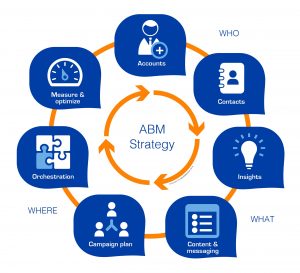Shall we get together over coffee?
What makes account-based marketing a success?

In a series of round table meetings at SPOTONVISION, marketers share their experiences. Today’s subject is account-based marketing (ABM) and our main question is “How can you truly measure the ROI of ABM?” Experienced B2B marketers from Schiphol Real Estate, CGI and T-Mobile share their thoughts. Many times research shows that ABM yields more profit than regular marketing campaigns, but how does this work?
Start at the beginning
A key requirement of successful ABM is to drive close teamwork between Marketing and Sales and focus on a specific account, or a group of target accounts. Start by setting goals for you and your team at an account level. Sales teams regularly have their own account opportunity list and that is a great start for an ABM-strategy.
Let’s have a conversation
Ratio, realism and risk
At the IT and Business consultancy company CGI, they start with the following ratio: insight into the probability of success. For example: What is the chance that Sales can land that one deal? The higher the chance, the more reason to invest marketing budget in helping to win the account. So first you calculate the chance of converting the prospect. Are the chances positive? Then go for it!
Next step would be to write the targeted account names on the whiteboard. You want to understand which of your colleagues are of value to successfully executing the plan. For every account you map the different possibilities, the required time and resources. Preferably you make your choices based on data. It is important to keep checking whether your plan is realistic. Do you have the right resources in place and do you have the internal support to complete the project?
Last but not least you need to calculate the risks. Sometimes you are working out your plans and start working on the project when suddenly large, impactful changes appear at the target account. Depending on your ways of working you can anticipate on these changes. For a company like Schiphol Real Estate a reorganisation at a target account has direct impact on their account plans and execution.
When you start using the three metrics (ratio, realism and risk) you are well on your way. The biggest challenge however is to make your activities scalable. We all know that large batch and blast campaigns will not work. But, when addressing the need of personalised account-based activities we need to think of an approach to scale.
How can you make ABM scalable?
Over the years we have learned that ABM campaigns need to be scalable to work. If all the efforts are directed on only a few accounts this can take up a lot of resources without the required return on investment.
At T-Mobile they use their time effectively with respect to planning and content. A lot of attention is put into segmenting the accounts first. This is because the target group would otherwise be too diverse and on the other hand if you invest in a few target accounts only, things would quickly become too expensive. You can easily segment on known classifications like region, industry and company size. Additionally it is also possible to segment in different areas that play a role in the market, e.g. durability, sustainability or co-creation opportunities. This way you can tailor campaigns for either industry marketing, or industry ABM.
The choice of accounts and the level of investment will be driven by where sales and marketing jointly believe they have the greatest chance of success. Do you have a smaller defined market where you can find big deals? In that case ABM is definitely interesting. Or do you have a bigger market where the size of the deal is smaller? A preferred option would be to start a thematic or industry campaign.
Share your successes
All stages of developing and executing your ABM-strategy take a lot of time. However you will find that there are many moments to celebrate your success. Don’t get distracted by the delusion of the day and take time to evaluate. So once more: share your successes however small they might be.

Which moments should you celebrate?
- Have you arrived at your target account list or your segmentation based on ratio, realism and risk? And do you have hands together with the Sales and Marketing team? Hooray! May be celebrated!
- Have you collected account insights and also gained insight into the contacts you already have within the accounts? It is a real achievement to complete this first deep dive.
- Do you have insights in the content needs of your contacts within your accounts? You can now really get started your campaign development. Celebrate the kick off together!
- Do you see more engagement of your target accounts with your company, online and offline? Continuously monitor progress – using a dashboard – and discuss the results.
- Do you convert the account into a customer? Yes, champagne can be opened!
Concluding
To answer the question “What makes ABM successful?” There is no easy answer. The success depends on a lot of different factors. What becomes clear is that the start, the assumptions and the co-operation between the Sales and Marketing teams are the most important ones. Without a proper start, it will be difficult to reach the results and to get the maximum ROI.
Want to know more about ABM please contact us
Share this article
Related insights
Grow your B2B Marketing knowledge
Subscribe to keep up with our latest B2B Marketing updates and exclusive events. Straight to your inbox, once a month.



